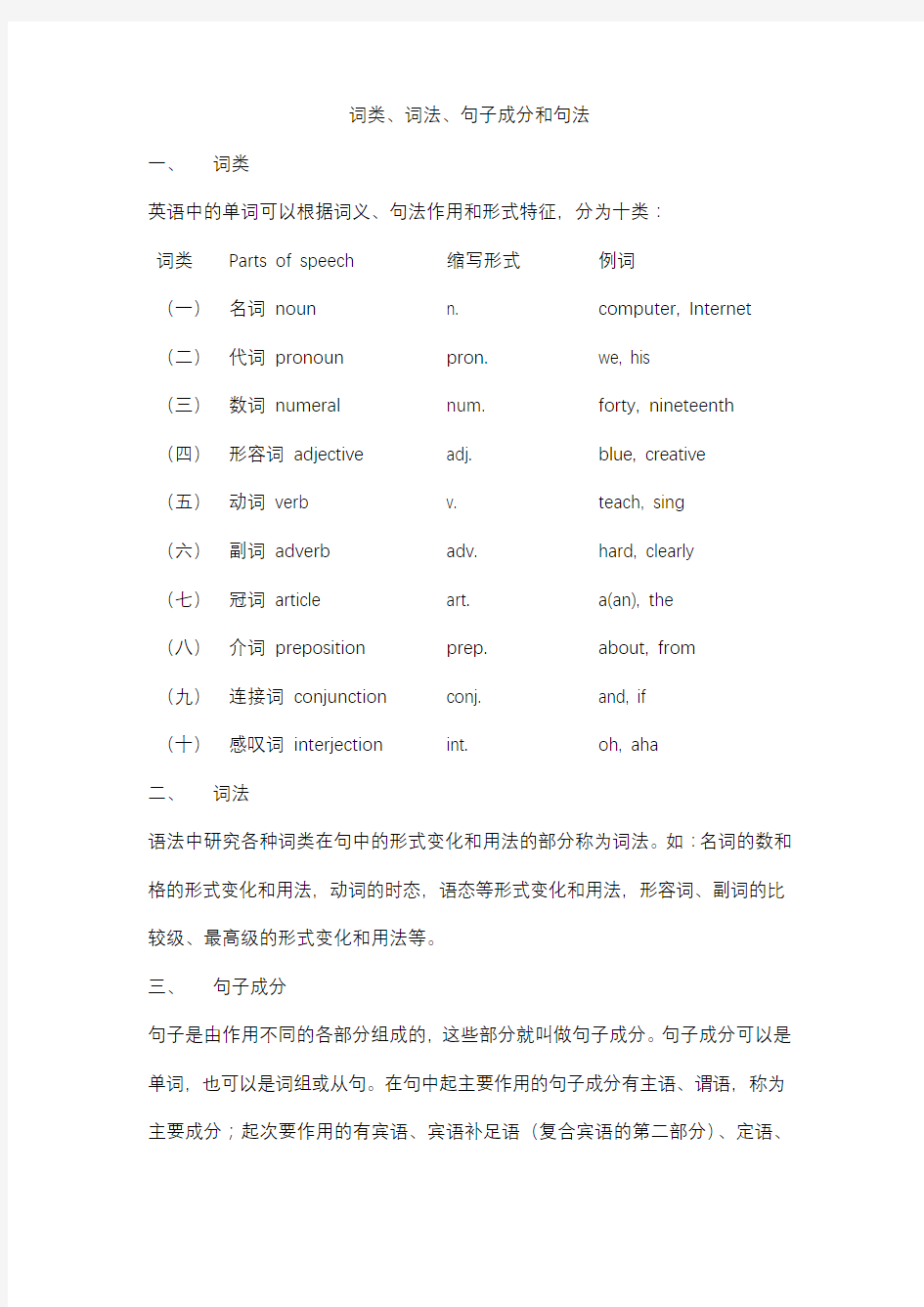词类、词法、句子成分和句法(有练习且包含答案)

- 1、下载文档前请自行甄别文档内容的完整性,平台不提供额外的编辑、内容补充、找答案等附加服务。
- 2、"仅部分预览"的文档,不可在线预览部分如存在完整性等问题,可反馈申请退款(可完整预览的文档不适用该条件!)。
- 3、如文档侵犯您的权益,请联系客服反馈,我们会尽快为您处理(人工客服工作时间:9:00-18:30)。
词类、词法、句子成分和句法
一、词类
英语中的单词可以根据词义、句法作用和形式特征,分为十类:
词类Parts of speech 缩写形式例词
(一)名词noun n. computer, Internet (二)代词pronoun pron. we, his
(三)数词numeral num. forty, nineteenth (四)形容词adjective adj. blue, creative
(五)动词verb v. teach, sing
(六)副词adverb adv. hard, clearly
(七)冠词article art. a(an), the
(八)介词preposition prep. about, from
(九)连接词conjunction conj. and, if
(十)感叹词interjection int. oh, aha
二、词法
语法中研究各种词类在句中的形式变化和用法的部分称为词法。如:名词的数和格的形式变化和用法,动词的时态,语态等形式变化和用法,形容词、副词的比较级、最高级的形式变化和用法等。
三、句子成分
句子是由作用不同的各部分组成的,这些部分就叫做句子成分。句子成分可以是单词,也可以是词组或从句。在句中起主要作用的句子成分有主语、谓语,称为主要成分;起次要作用的有宾语、宾语补足语(复合宾语的第二部分)、定语、
状语、表语等,称为次要成分。
四、句法
语法中研究各成分之间的关系、句子的种类和分析句子结构的部分称为句法。
五、词类和句子成分的关系
词法和句法是我们研究语法的两个基本内容,要掌握这两个基本内容,首先必须了解词类相互间的关系和词类与句子成分的关系。
(一)词类相互间的关系
1. 形容词、数词通常修饰名词(有时名词也可以修饰另一个名词),形容词还可以修饰代词。例如:
1)The three tall and strong men are all basketball players.
2)The writer often writes something interesting about children.
2. 副词常修饰动词、形容词和副词。例如:
1)His sister plays the piano quite well.
2)The story is very instructive.
3. 冠词、介词、连接词和感叹词称为虚词。它们在句中不能单独构成句子成分,只起辅助和连接的作用。冠词只用于名词之前,辅助指明名词的含义;介词与它后面的名词或代词构成介词短语时,才能在句中作一定的成分(定语、状语和表语)。例如:
The league members of Class Two are having the League meeting in the school yard.
连词只起连接词、词组和句子的作用。感叹句只用作句子里的独立成分,一般放在句首。例如:
Oh, it is raining so hard that we have to stay indoors.
(二)词类与句子成分的关系:词类和句子成分本来就是两个完全不同的语法概念,但却有着密切的关系,因为词类在句中所起的作用不同,就形成了句子的各个不同的成分。
1. 主语:是句子要说明的人或物,是句子的主体,一般放在句首。名词、代词、数词常在句中用作主语。此外,动名词、动词不定式、主语从句也可以用作主语。例如:
1)Comrade Chen is a well-known scientist.
2)He reads newspapers every day.
3)Two and six is eight.
4)Smoking is harmful to the health.
5)To swim in the Kunming Lake is a great pleasure.
6)What we shall do next is not yet decided.
2. 谓语:说明主语的动作或状态。动词在句中做谓语,一般放在主语之后。例如:1)The new term begins on the 1st of September.
2)Her father is an engineer.
3)She seemed tired.
4)Li Hua showed me his album.
3. 宾语:及物动词涉及到的人或物称为动词宾语。宾语一般放在及物动词之后。介词后面的名词或代词称为介词宾语。名词、代词、数词在句中常用作动词宾语或介词宾语。此外,动词不定式可用作动词宾语,动名词和宾语从句也可以用作动词宾语或介词宾语。例如:
1)Wang Ling lent me a novel to read in the bus.
2)The medicine is good for a cough.
3)How many notebooks do you want?
4)She tore the cloth in two.
5)Please give the letter to her.
6)My little sister always likes to ask questions.
7)Would you mind coming earlier tomorrow?
8)His brother is good at playing chess.
9)He asked me what I was going to do in summer.
4.宾语补语(复合宾语的第二部分):在宾语的后面补充说明宾语的动作、状态、特征的成分称为宾语补语。名词、形容词、副词、介词短语以及动词不定式、分词等可作宾语补语。例如:
1)The government appointed her chief delegate to the conference.
2)I don’t believe the story true.
3)He found the meeting over when he arrived there.
4)You should put your things in order.
5)The doctor advised her to stay in bed for a week.
6)We saw the pupils playing basketball.
5. 表语:在系动词后用来说明主语的身份、状态或特征的成分是表语。可做表语的有名词、代词、形容词、副词、介词短语以及动词不定式、动名词、分词和表语从句等。例如:
